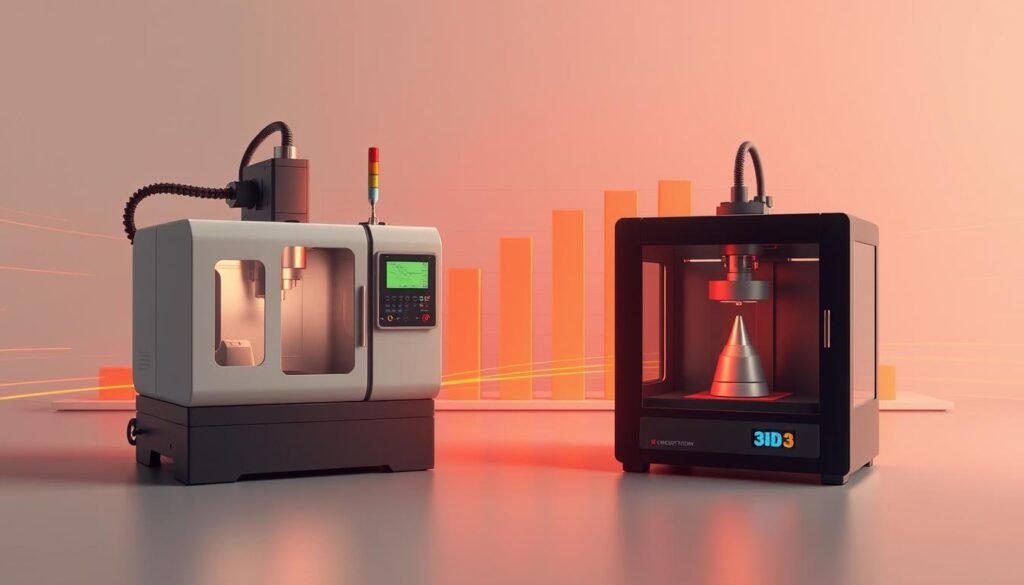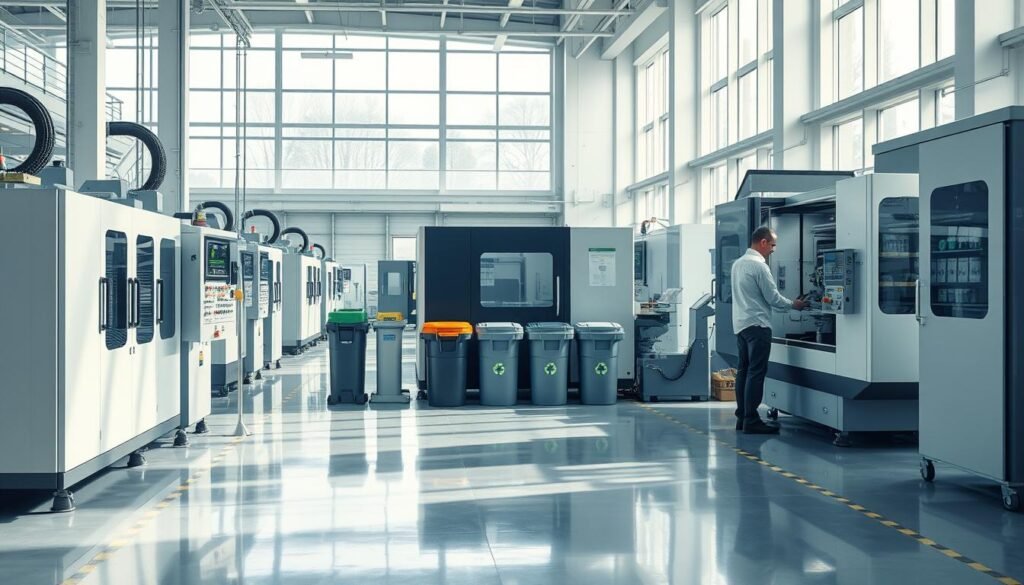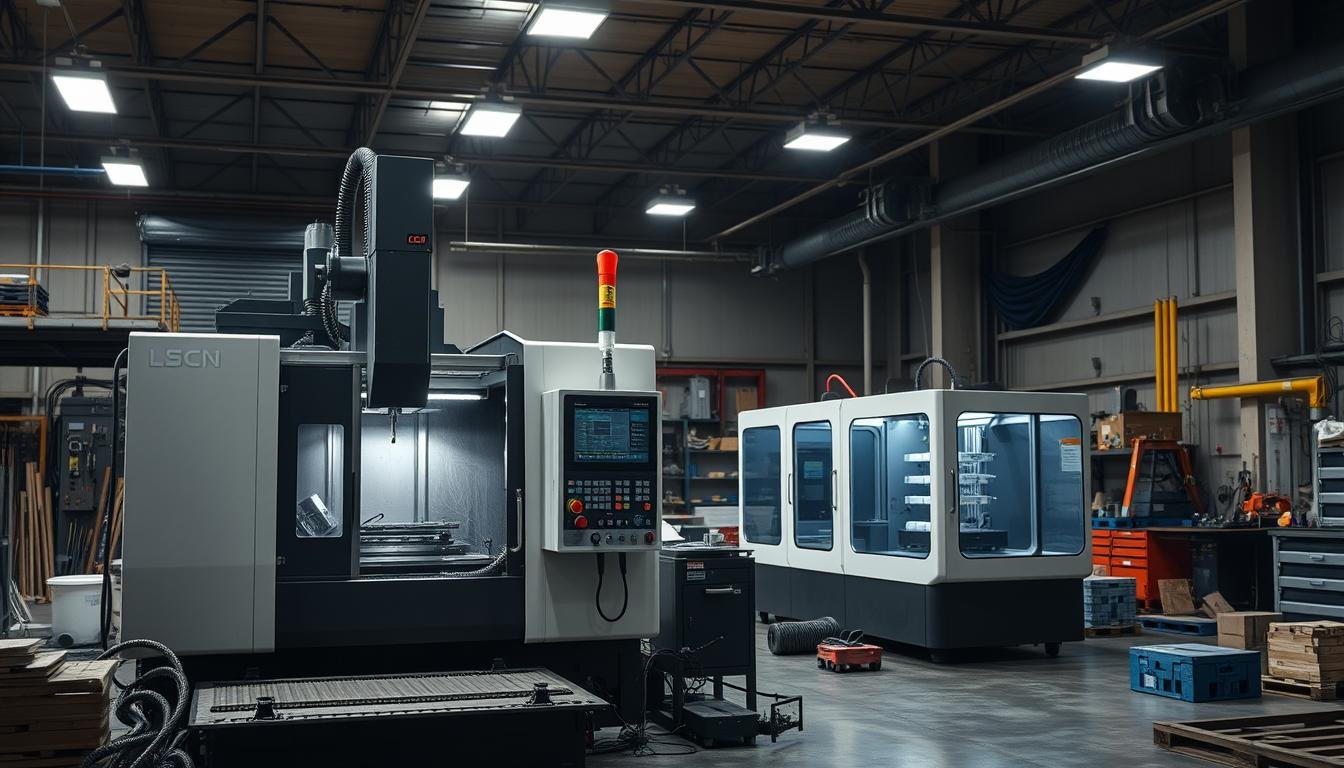In today’s fast-changing world, knowing the difference between CNC Machining and 3D Printing is key. Both are important in making solid parts. CNC Machining takes away material to make precise parts. On the other hand, 3D Printing adds material layer by layer, creating complex shapes.
This article will explore each method’s strengths and weaknesses. It aims to help you choose the right one for your needs.
Key Takeaways
- CNC Machining involves material removal, whereas 3D Printing utilizes additive processes.
- Both technologies are essential for different manufacturing requirements.
- Understanding the strengths of each method aids in optimizing production outcomes.
- Precision manufacturing is a critical factor in both CNC Machining and 3D Printing.
- Different industries may prefer one technology over the other based on specific needs.
Introduction to CNC Machining and 3D Printing
In today’s world, knowing how things are made is key. This part is about Introduction to CNC Machining and Introduction to 3D Printing. We’ll look at what makes each special and where they’re used.
CNC Machining is known for its accuracy. It makes parts that are top-notch. This is why it’s a must in places like aerospace and cars, where parts need to be just right.
On the other hand, 3D Printing is a big deal for quick prototypes and custom stuff. It lets you make complex designs that old ways can’t handle. This means companies can be more flexible and creative.
Looking closer at these methods shows their strengths. Mixing CNC Machining with 3D Printing can really help with making things. For more on how they stack up, check out this link.
Understanding CNC Machining
CNC machining is a big step forward in making things. It changed how we make things by making them more precise and efficient. It all started in the 1950s with computer control, making old ways of making things seem outdated.
Process Overview and History
CNC technology changed the game in making things. Before, making things was hard work with simple tools. But then, computers came along and made things easier. Here are some important moments:
- 1950s: CNC started with simple tools and punch cards.
- 1960s: Programming got better, making designs more complex.
- 1970s-1980s: Computers got faster, making things more precise and quicker.
- Today: CNC is used with many materials and for different things.
Types of CNC Machines
There are many CNC machines out there, each with its own job. They help make different things in various ways:
| Type of CNC Machine | Functionality | Common Applications |
|---|---|---|
| CNC Mill | Removes material using rotating cutting tools | Parts manufacturing, mold making |
| CNC Lathe | Turns workpieces to shape with precise angles | Spindle components, shafts |
| CNC Router | Cuts, drills, and engraves with precision | Woodworking, plastics |
| CNC Plasma Cutter | Melts and cuts metal using plasma | Fabrication, automotive parts |
| CNC Laser Cutter | Utilizes a laser beam to cut and engrave | Signage, intricate designs in various materials |
These machines show how CNC technology is used in many areas. It makes making things more efficient and precise.
Understanding 3D Printing
3D printing is a special way to make things. It’s also known as additive manufacturing. This method turns digital designs into real objects. It’s fast and useful for many things, like making prototypes or lots of products.
Additive Manufacturing Techniques
There are many ways to do additive manufacturing. Each has its own benefits and uses. Here are a few key 3D printing techniques:
- Fused Deposition Modeling (FDM): It uses melted plastic to build objects layer by layer.
- Selective Laser Sintering (SLS): This method uses a laser to melt and fuse powdered materials, like nylon.
- Stereolithography (SLA): It cures liquid resin with UV light, making detailed parts with smooth surfaces.
These methods make additive manufacturing very flexible. They allow for many materials, like plastics and composites, in different projects. These 3D printing processes have changed how we design and make things. They help bring new ideas to manufacturing.
Key Differences Between CNC Machining and 3D Printing

Looking at CNC vs 3D Printing, we see big differences. CNC machining takes away material from solid blocks. 3D printing, on the other hand, adds layers to make objects.
Knowing the Differences in Manufacturing is key for experts. CNC machining is great for parts needing tight tolerances and smooth finishes. It’s perfect for high-precision components.
3D printing shines in making complex shapes hard to achieve with traditional methods. It’s great for quick prototypes and small batches. Designers can explore new ideas without the usual limits.
Skills needed for Production Methods Comparison vary a lot. CNC machining needs skilled operators for programming and setup. 3D printing focuses more on design and material knowledge. Knowing these differences helps businesses pick the right tech for their projects.
Material Use in CNC Machining
CNC Machining is key in making precise parts from different materials. The choice of CNC Machining Materials greatly affects the product’s quality. Knowing the materials used and their properties helps us understand CNC better.
Types of Materials Utilized
Many materials are used in CNC machining. Each has its own role:
- Metals: Aluminum, steel, titanium, and brass are strong and last long.
- Plastics: Polycarbonate, acrylic, and nylon are light and don’t rust.
- Composites: Carbon fiber and fiberglass are strong but light, perfect for special uses.
Properties of Machined Parts
The qualities of machined parts are crucial for their use. CNC machining keeps important material traits, like:
- Strength: Keeps parts strong.
- Dimensional accuracy: Gets parts to fit perfectly.
- Surface finish: Makes surfaces smooth, improving looks and function.
Choosing the right CNC Machining Materials helps keep products at their best. This focus on quality helps businesses meet their goals.
Material Use in 3D Printing
In 3D printing, knowing about materials is key to getting the best results. Many materials are used in 3D printing. Each one has special benefits for different projects.
Common 3D Printing Materials
Here are some common 3D printing materials:
- PLA (Polylactic Acid): This biodegradable plastic is easy to work with and looks good.
- ABS (Acrylonitrile Butadiene Styrene): It’s strong and durable, great for parts that need to work hard.
- Nylon: Known for being tough and flexible, it’s perfect for parts that need to last.
- TPU (Thermoplastic Polyurethane): This material is like rubber, making it very flexible and strong.
These materials show how diverse 3D printing can be. Each one meets different needs in making things.
Material Properties of 3D Printed Parts
The qualities of 3D printed parts are very important. They affect how well parts work and look. Key traits include:
- Strength: Parts can be strong or weak, depending on the material and how it’s printed.
- Layer Adhesion: How well layers stick together is crucial for the part’s strength.
- Surface Finish: The look of the surface can be smooth or rough. It affects both looks and function.
- Heat Resistance: Some materials, like ABS and nylon, handle heat better than others, like PLA.
Knowing about these qualities helps choose the right material for a project. This ensures parts work well in many areas.
Precision and Tolerance in Manufacturing
Precision in CNC machining is key for tight tolerances. It meets exact manufacturing needs. This method can achieve tolerances as low as ±0.002 inches. This is unmatched manufacturing accuracy.
Many things affect this precision. These include machine calibration, tooling quality, and how it’s used.
Tolerance in additive manufacturing varies more. It depends on the 3D printing method and materials used. For example, Fused Deposition Modeling (FDM) shows more variation than Stereolithography (SLA). Knowing these differences helps pick the right method for each job.
The table below shows tolerance differences between methods:
| Manufacturing Method | Tolerance Range | Factors Influencing Precision |
|---|---|---|
| CNC Machining | ±0.002 inches | Tooling quality, machine calibration, operator skill |
| 3D Printing (FDM) | ±0.005 to ±0.030 inches | Material used, layer height, printer settings |
| 3D Printing (SLA) | ±0.003 to ±0.010 inches | Resin properties, light exposure, build orientation |
Production Speed: CNC Machining vs 3D Printing

CNC machining and 3D printing have different speeds. Knowing these speeds helps in planning production. This is key for making good choices in how to make things.
CNC machining is usually faster because it cuts through materials well. It can make complex parts quickly. For big batches, CNC machines are faster to set up, making production better.
3D printing’s speed depends on the technology and part complexity. It’s great for making detailed shapes. But, making a part can take longer because it builds up layer by layer.
| Criteria | CNC Machining Speed | 3D Printing Speed |
|---|---|---|
| Setup Time | Shorter for larger batches | Longer due to layer preparation |
| Material Removal Rate | High | Low |
| Complex Part Processing | Fast for simpler parts | Optimized for intricate designs |
| Overall Production Speed | Typically faster in bulk | Varies widely based on technology |
In short, CNC machining is often faster, which is good for making lots of things. But, 3D printing is great for detailed parts. Knowing these differences helps choose the best method for each need.
Cost-Effectiveness of CNC Machining and 3D Printing
When we compare CNC machining and 3D printing, we look at several things. These include the cost to start, how much it costs to run, and the price of making parts. Knowing these helps us see how each technology works best in different situations, like manufacturing costs.
Initial Investment and Operating Costs
CNC machining starts with a big cost. You need to buy the machine, set it up, and train people to use it. Prices can go from $35,000 to over $100,000, based on what the machine can do. Then, there are ongoing costs like keeping the machine running and buying tools.
3D printing, on the other hand, often starts with a smaller cost. You can find printers for under $5,000. But, industrial printers can cost more than $100,000. Running costs depend on the materials and energy used, but they might be easier to handle for small batches.
Cost per Part: Low vs High Volume
CNC machining is great for making lots of parts. As you make more, the cost goes down. This is because you spread out the setup costs over more parts, making each one cheaper.
3D printing is better for making a few or special parts. It’s good for prototypes or unique items. Since you don’t need to set up much for each part, it can be cheaper for small runs.
| Factor | CNC Machining | 3D Printing |
|---|---|---|
| Initial Investment | $35,000 – $100,000+ | $5,000 – $100,000+ |
| Operating Costs | Higher due to maintenance and tooling | Lower for materials, but variable based on usage |
| Cost per Part (Low Volume) | Higher due to setup | Lower, more economical for fewer units |
| Cost per Part (High Volume) | Lower with economies of scale | Higher; not advantageous at scale |
For more details on these costs, check out our full report on CNC machining costs. Knowing these costs helps businesses make smart choices and improve their manufacturing plans.
Sustainability and Waste Generation

Sustainability in manufacturing is key for industries wanting to lessen their environmental impact. A big part of this is looking at waste in CNC machining and 3D printing. CNC machining cuts out material, leading to a lot of waste.
3D printing, on the other hand, adds material layer by layer. This makes much less waste because it only uses what’s needed. It’s better for the planet and lets for new designs that use less material.
To give a better view, here’s a table comparing waste from both methods:
| Manufacturing Process | Typical Waste Generation | Material Recycling Potential |
|---|---|---|
| CNC Machining | High – often up to 70% of material | Limited; varies by material |
| 3D Printing | Low – approximately 10-15% of material | High; many materials can be recycled |
In short, the differences in waste between CNC and 3D printing show we need to focus on being green. By using materials wisely and recycling, we can make things better for everyone and the planet.
Plastic Injection Molding: An Alternative Manufacturing Method
Plastic Injection Molding is a top choice for making plastic parts. It uses the Injection Molding Process. This method is great for making detailed designs with high accuracy.
Overview of Plastic Injection Molding
The process starts with heating plastic pellets until they melt. Then, the melted plastic is pushed into a mold. It cools and hardens, creating the part’s shape. It uses strong materials like thermoplastics and thermosetting polymers.
Comparison with CNC Machining and 3D Printing
Let’s look at how Plastic Injection Molding compares to CNC machining and 3D printing:
| Feature | Plastic Injection Molding | CNC Machining | 3D Printing |
|---|---|---|---|
| Production Speed | High-speed for large volumes | Moderate, slows for complex parts | Slower, ideal for prototypes |
| Cost-Effectiveness | Cost-effective at scale | High initial costs, low for certain runs | Higher costs for large volumes |
| Geometric Capabilities | Excellent for complex shapes | High precision but limited to subtractive | Adaptable for intricate designs |
| Part Quality | Uniform and consistent quality | High-quality surface finish | Quality varies with technology |
Learning about the difference between CNC and 3D printing shows each method’s unique strengths. Plastic Injection Molding is best for making lots of parts quickly.
Applications and Industry Use Cases

CNC machining and 3D printing are used in many industries. They are key in modern manufacturing. Each field uses these technologies to improve production and meet specific needs.
In the aerospace field, CNC makes parts like airfoils and landing gears. It needs a lot of precision and follows strict rules. The medical world uses these methods for making surgical tools and custom implants. This ensures safety and accuracy.
Car makers use CNC for engine parts and dashboard panels. It helps make lots of parts quickly and with the same quality. 3D printing is great for making prototypes and small parts fast.
The marine industry uses CNC for strong deck and hull parts. It focuses on making things faster. In the energy field, these methods help make parts for green energy like wind and solar.
Here’s a quick look at where CNC machining and 3D printing are used:
| Industry | Applications of CNC | Applications of 3D Printing |
|---|---|---|
| Aerospace | Airfoils, landing gear, engine components | Prototypes, lightweight components |
| Automotive | Engine parts, gearboxes, dashboard panels | Prototyping, custom parts |
| Medical | Surgical tools, prosthetics | Personalized implants, anatomical models |
| Marine | Hull structures, deck components | Custom fittings |
| Electronics | PCBs, enclosures | Casings, custom connectors |
These examples show how CNC machining and 3D printing help many industries. For more on CNC precision parts, check out this link.
Conclusion
We looked into CNC Machining and 3D Printing in this article. Both have their own benefits for different needs. We want to help manufacturers make informed choices.
CNC Machining is great for making precise parts with strong materials. It’s perfect for places where exactness is key. 3D Printing, on the other hand, is flexible for quick prototypes and complex shapes. It helps in bringing new ideas to life.
Our goal is to help you understand these technologies better. This way, you can pick the right method for your project. It’s all about matching the right tool with your goals.
We hope our comparison helps you make better choices for your production. Remember, each method has its own strengths. This knowledge can lead to better manufacturing strategies today.
FAQ
What is CNC Machining?
CNC Machining uses computer-controlled machines to make parts. It removes material from a solid block. This method is great for making precise parts in many industries.
How does 3D Printing work?
3D Printing adds material layer by layer to make parts. It uses digital models and materials like polymers. Techniques like FDM and SLS are common.
What are the main differences between CNC Machining and 3D Printing?
CNC Machining removes material, while 3D Printing adds it. They differ in precision, surface finish, speed, and cost. Each is best for different needs.
What types of materials are used in CNC Machining?
CNC Machining uses metals, plastics, and composites. Each material affects the part’s properties.
What are the advantages of 3D Printing over traditional methods?
3D Printing offers design freedom, less waste, and fast prototyping. It’s great for complex shapes and small batches.
Can CNC Machining produce parts to tight tolerances?
Yes, CNC Machining can achieve very tight tolerances. This is key for aerospace and medical devices.
How cost-effective is CNC Machining for large production runs?
CNC Machining is cost-effective for big batches. Setup costs are high, but costs drop as volume grows.
What sustainability factors should I consider for these manufacturing methods?
Look at waste, energy, and material use. CNC Machining makes more waste, while 3D Printing uses less.
What industries commonly use Plastic Injection Molding?
Many industries use Plastic Injection Molding. It’s good for making complex parts in large quantities.
How does Plastic Injection Molding compare to CNC Machining and 3D Printing?
Plastic Injection Molding is faster for big batches. It’s cheaper at scale but less flexible for design changes.


